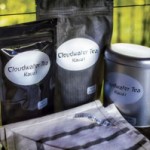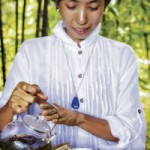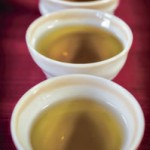The Taste Of Kaua‘i In A Teacup
Slender stalks of black bamboo sway in the cool breeze as the late afternoon sun casts golden rays and long shadows. I’m sitting on an elevated lanai listening to Michelle Rose, owner of Cloudwater Tea.
“There are five processes of tea,” she says, as her assistant Bon Moore sets down a tray of freshly brewed white tea. “The first process is white, then we have green, wulong, black and pu-erh.” The last is a variety of post-fermented tea.
Hawaii’s tea industry is small. There are 10 commercial farms on the Big Island, two on Maui, and this one in Kilauea. Last year, Hawaii grew and sold 300 pounds of tea, and 15 of them were from Rose’s farm. It takes 5 pounds of fresh leaves to make 1 pound of tea.
“We call them Hawaii-grown teas,” she says, correcting me after I call them Hawaiian teas. “They are generally quite sweet, and it doesn’t matter how long you steep them, they’re not bitter.”
Rose, whose slender frame is cloaked in a light blue dress, has just shown my husband Dan and I around her 10-acre farm. Eight cultivars of tea grow on a quarter-acre, and pandanus trees mix with patches of bamboo, thwarting the wind. Goats and chickens roam freely, and the lazy Pohakuhonu Stream winds through the property.
“Tea plants are trees,” she says. A wisp of her blond hair catches the wind. “Each tea seed is not true to the mother, like an apple tree. So you get all these rogue varieties. To get the same things every time, we have to do vegetal cuttings.”
It takes seven years to go from cutting to harvestable leaves. Starting in March and running through October, new “flush” is harvested by hand, and hand-processed in 5-pound batches.
Rose makes an assam cultivar into Golden Assamica Black. She also makes Twisted Black, Wok Roasted Green, Wai Lani White and Walking Stick Wulong, or oolong in simplified Chinese.
“White tea is just-picked leaves that are dried over three days,” she says, pointing to the tea that has steeped for 15 minutes. “So you’re getting what the leaf tastes like, unprocessed.” The tea is in a wide, professional tea-cupping cup. It smells fresh and floral, and tastes light, like a summer whisper.
Green tea is presented in handmade ceramic cups that her friends made. “After I pick the leaves, I let them wilt for about an hour so it’s flexible. I gently roll it into a ball to break up the cell wall, and I put it in a hot wok for 90 seconds. I take it out, fluff it, and roll it again. I roll and roast about 10 times before I dry it.”
Just when the water starts to boil, it’s poured over the green tea and steeps for seven minutes. The taste is clean, sweet, lemony and a little grassy. There is some astringency, but it’s not too noticeable. It’s the mildest green tea I’ve ever tasted.
“Wulong is the most elusive tea there is,” Rose says, as Bon sets another tray down. “It’s characterized by many rollings and many hours, and takes 36 hours to make.”
The tea’s flavor is more layered and complex because of the amount of rolling it goes through.
There are hints of ginger, honey, ripe persimmon and a yamminess, like a sweet potato. No hint of bitter tannins disrupts the flavor of this tea.
“With the wulong, I heat the tea first and then roll it. But I do the opposite with the black tea,” Rose says. “It’s rolled for many iterations, for about an hour in length. It depends on the atmosphere, what the tea’s doing, what season it is, how sticky it is, and what color it is. I just have to be with the tea.”
The black tea takes 24 hours to process, and is steeped for seven minutes.
There is no bitter or astringent taste. It’s robust, earthy, with a bronzy-honey taste. “It tastes like the earth here,” she says. “If one could taste Kaua’i, this is what it would taste like.”
Having met the person who grows the tea I just tasted leaves me feeling content – complete. “Tea should be intimate,” she says, as the bamboo leafs rustle in the breeze. “It should be grown in beautiful tea gardens, surrounded by mountains. It should have a soul.”
Cloudwater Tea 828-0741 cloudwatertea.com
- Michelle Rose, owner of Cloudwater Tea. Daniel Lane photos
- Cloudwater Tea is only available at the farm
- Pohakuhonu Stream winds through Cloudwater Tea Farm
- Bon Moore brews a perfect cup
- Walking Stick Wulong
- Wulong Cloudwater Tea
- Wai Lani White
- Wok-roasted Green. Daniel Lane photos











